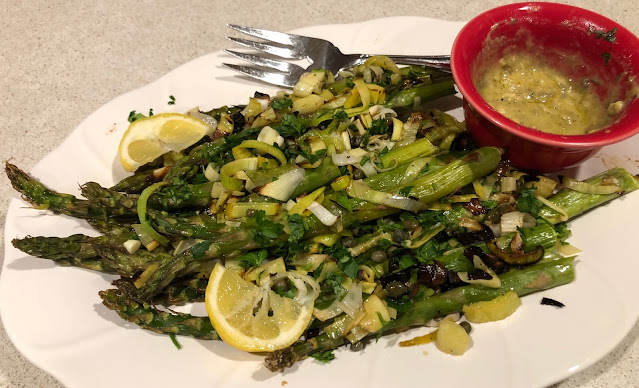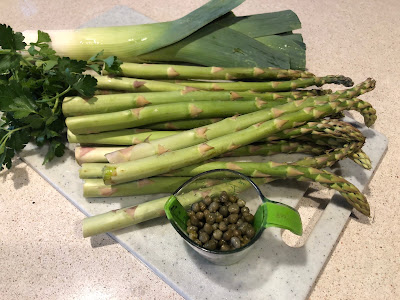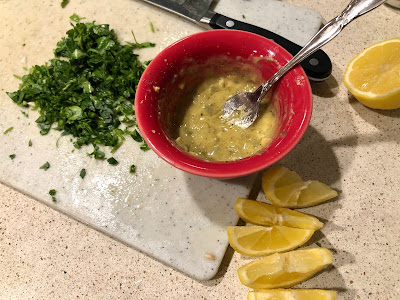
Recipe: Celebrate the new season with an easy vegetable side

|
I'm so happy to see asparagus show up. It means spring is arriving and all the other great vegetables of the season will soon follow.
Grilled asparagus is my favorite, but roasted is right behind. And with propane still hard to find (thanks, Covid-19), I'd just as soon use my oven as much as possible now to cook and hope I can fire up the grill for real later.

|
This roasting recipe, adapted from one by the New York Times' Melissa Clark, specifically calls for fatter asparagus stalks, which I prefer anyway. I grew up in Stockton, which once was the center of asparagus farming in California. Something about that Delta soil, I think.
The sauce here is optional but it is excellent. Just saying. And don't skip the fresh lemon juice -- it cuts through the richness of the Dijon mustard beautifully.
Roasted asparagus with crispy leeks and capers
Serves 3-4 as a first course or side
Ingredients:
1 pound thick asparagus stalks (1/2-inch diameter or larger), ends trimmed
2 tablespoons extra-virgin olive oil, divided
Salt and freshly ground black pepper

|
2 tablespoons drained capers
1 lemon, halved, then cut into 8 wedges (some will be used in the sauce)
1/4 cup chopped fresh parsley
For sauce:
2 teaspoons Dijon mustard
2 teaspoons drained capers, finely chopped
1 garlic clove, minced
2 tablespoons extra virgin olive oil
Salt and freshly ground pepper
Instructions:
Heat oven to 425 degrees. Place trimmed asparagus on a rimmed baking sheet and toss with 1 tablespoon olive oil and 1/2 teaspoon salt.
Put the leek slices in a bowl and stir in the other 1 tablespoon olive oil and a pinch of salt and a few grinds of pepper. Scatter the leeks over the asparagus on the pan, then scatter the capers over that.
Roast the asparagus 12-18 minutes, until the asparagus is tender and showing some golden brown.
Make the sauce while the asparagus is roasting. Stir together the mustard, capers and garlic in a bowl, then slowly stir in, 1 at a time, the 2 tablespoons of olive oil until it forms a thickish emulsion. Squeeze the juice from two of the lemon wedges into the sauce, and stir until combined. Taste and adjust seasoning with salt and pepper.

I got a little carried away when cutting up the lemon.
Slicing each half into fourths is sufficient. Two
wedges of juice are used in the sauce. |
Serve with the mustard sauce and the remaining lemon wedges on the side.
I highly recommend serving small white beans with this if it is part of a full meal -- the beans play especially well with the leeks and the mustard.
Comments
0 comments have been posted.Sacramento Digs Gardening to your inbox.
Sites We Like
Garden Checklist for week of April 21
This week there’s plenty to keep gardeners busy. With no rain in the immediate forecast, remember to irrigate any new transplants.
* Weed, weed, weed! Get them before they flower and go to seed.
* April is the last chance to plant citrus trees such as dwarf orange, lemon and kumquat. These trees also look good in landscaping and provide fresh fruit in winter.
* Smell orange blossoms? Feed citrus trees with a low dose of balanced fertilizer (such as 10-10-10) during bloom to help set fruit. Keep an eye out for ants.
* Apply slow-release fertilizer to the lawn.
* Thoroughly clean debris from the bottom of outdoor ponds or fountains.
* Spring brings a flush of rapid growth, and that means your garden is really hungry. Feed shrubs and trees with a slow-release fertilizer. Or mulch with a 1-inch layer of compost.
* Azaleas and camellias looking a little yellow? If leaves are turning yellow between the veins, give them a boost with chelated iron.
* Trim dead flowers but not leaves from spring-flowering bulbs such as daffodils and tulips. Those leaves gather energy to create next year's flowers. Also, give the bulbs a fertilizer boost after bloom.
* Pinch chrysanthemums back to 12 inches for fall flowers. Cut old stems to the ground.
* Mulch around plants to conserve moisture and control weeds.
* From seed, plant beans, beets, cantaloupes, carrots, corn, cucumbers, melons, radishes and squash.
* Plant onion sets.
* In the flower garden, plant seeds for asters, cosmos, celosia, marigolds, salvia, sunflowers and zinnias.
* Transplant petunias, zinnias, geraniums and other summer bloomers.
* Plant perennials and dahlia tubers for summer bloom.
* Mid to late April is about the last chance to plant summer bulbs, such as gladiolus and tuberous begonias.
* Transplant lettuce seedlings. Choose varieties that mature quickly such as loose leaf.